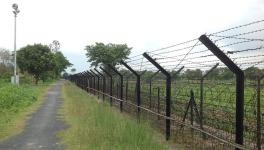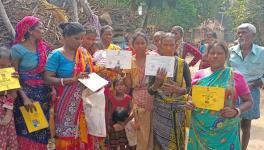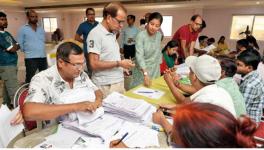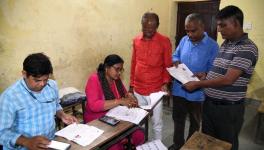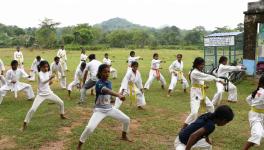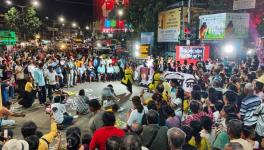Bengal: Is ‘Moyna Model’ of Pisciculture Supplying Poisonous Fish to Kolkata’s Kitchens?
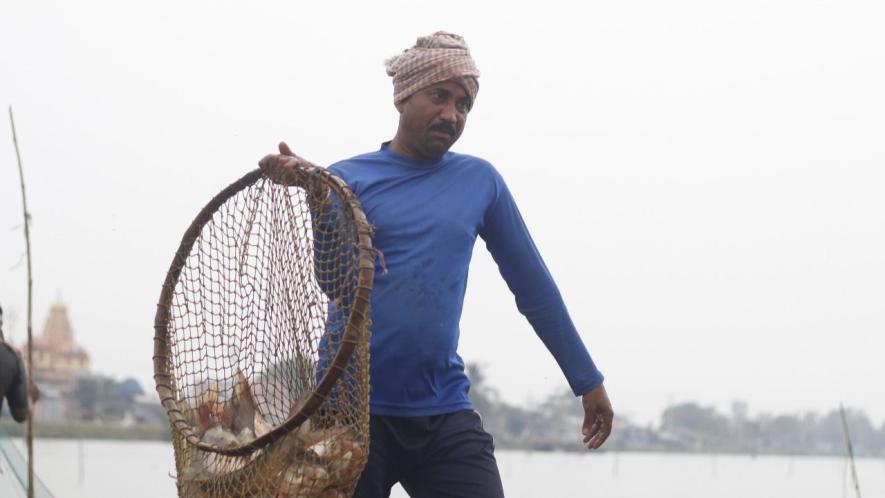
Kolkata: Is the Moyna model of fish cultivation (rearing fish in low-lying water-filled fallow crops lands), as being done now, inundating the fish market in Kolkata with spurious fish while keeping the demand-supply equation intact? This question has been raised in several quarters of late.
“It is a fact that without cultivation under this model, the prices of fish would see a huge spike, as Moyna model fish is priced lower (about Rs140-220/kg of Rohu and other carp fishes, which are consumed by the common persons, against Rs 280-320/kg for Rohu and carp Katla fish from sweetwater,” Nabakumar Pakhira, who has been selling fish for 25 years near Ratan Babur Ghat, told NewsClick.
Pakhira, who is also a state committee member of the All-India Fishermen and Fish Workers Federation (AIFFWF) alleged that chemicals, pesticides and growth hormones were rampantly being used in the Moyna model of pisciculture, leading complaints of a foul chemical smell while being cooked from various households. “The oil that comes out of the belly of these fishes melt, unlike fish from freshwater sources, which are edible and are not black in colour, like the Moyna model fish,” he added.
He also said even in the case of large carp fishes coming from Andhra Pradesh, formalin, a chemical commonly used to preserve dead humans, is used along with ice to preserve fishes which often take seven-eight days to reach the city.
The Moyna model of fish is cultivated in Moyna (the name of a block) and nearby places in bheris (water bodies) which till recently were being fed with residuals of ducks and chicken sourced from slaughter shops, adding that the state minister of fisheries should immediately look into the issue.
NewsClick tried to contact Biplab Roychoudhury, the state fisheries minister, but repeated calls went unanswered.
However, NewsClick spoke with Kiranmay Nanda, former fisheries minister in the Left Front cabinet from 1982 till 2011, and later a Samajwadi Party MP until 2018. Nanda said: “The (Moyna) model first introduced by his department around 2006 in the Moyna block of East Medinipur which used to remain inundated all 12 months of the year. Even rice cultivation was a challenging task in that block. Then, through scientific methods, small fish farmers used to cultivate fish in those lands. What is the condition of that project now, I cannot say.”
Various fishers organisations, including AIFFWF, the largest fishers union in West Bengal with one lakh membership, and Dakshinbanga Matsajibi Forum (DMF), a union of small fishers, has decried the Trinamool Congress (TMC) government and the Union government for making the Moyna model a flagship in the state for pisciculture and emulate the model in 18 other districts of West Bengal.
The AIFFWF national president Debasish Barman told NewsClick that the Moyna model had degenerated and small fishers had been ousted from fishing in their lands after 2014.
“Now, even non-low-lying land is being changed and inland water bodies are being created by excavation in order to cultivate fish. The bunds separating the land demarcation are mitigated and large inland water bodies are being created -- known as bheris.
He said he had heard of allegations from his organisation’s members, especially in Moyna and other nearby areas, that carp fishes are being cultivated using non-scientific methods by giving growth hormones in huge quantities and feeding fish residuals of dead animals.
Several media reports have alleged that ruling party ‘hooligans’ had transformed themselves as input dealers, and common fishers in the lure of making some extra money were falling into the trap. Many of fishers in the Moyna block had committed suicide after not being able to pay back the input dealers, Barman said citing some reports.
He also said that the land once taken for Moyna mode of cultivation was rendered unfit due to high chemical use. “No crop cultivation or even fish cultivation can take place in these ponds after four-five years,” he added.
Debasish Shyamal, secretary of Purba Medinipur Matshajibi Forum said that as an organisation they were against the Moyna model for its unscientific approach of fish cultivation and forcible land grab from fishers and cultivators. He said they already submitted a memorandum to the Block Development Officer and other officers against this model but none were heeding them as “it’s the Chief Minister’s pet project.”
Talking to NewsClick, Narayan Maity of Moyna block, who is also secretary of the block committee of Purba Medinipur Matshajibi Forum, said he used to own 10 cottahs of land in the Moyna block, which was a pond. “However the high bunds of the fish bheris under the Moyna model blocked the normal movement of water in the region and every time it rained, my pond overflowed, forcing me to hand over the land to the Moyna model. All small fishers have been forced to take such steps under Moyna whether they like it or not”, he said.
Maity said the change of land use though was illegal and was patronised by the state government. He said that he gets Rs 2,200 per month for each cottah of land given to the Moyna model and twice a year they are paid a total annual fee of Rs 44,000 for a year for 10 cottah of land. This amount is substantial and the lure of easy money without work has led to many giving up their land. These lands often turn barren after a few cycles. I am expecting the worst very soon,” he said.
Naba Dutta, an environmentalist and convenor of Sabuj Bachao Manch, told NewsClick, “the government is trying a quantitative increase of fish yield and is not going for qualitative increment. This is creating a roadblock for biodiversity in the state, The environment is being hampered. Cleaning of water bodies is not being done. In the fish markets of the state, especially in Kolkata and North and South 24 Parganas, and suburbs of Kolkata, 80% of fish sold are Moyna model fishes, In various places, the water feeder canals and rivers that were instrumental in irrigation have been diverted to create artificial inland bodies. This is leading to biodiversity loss in the state”.
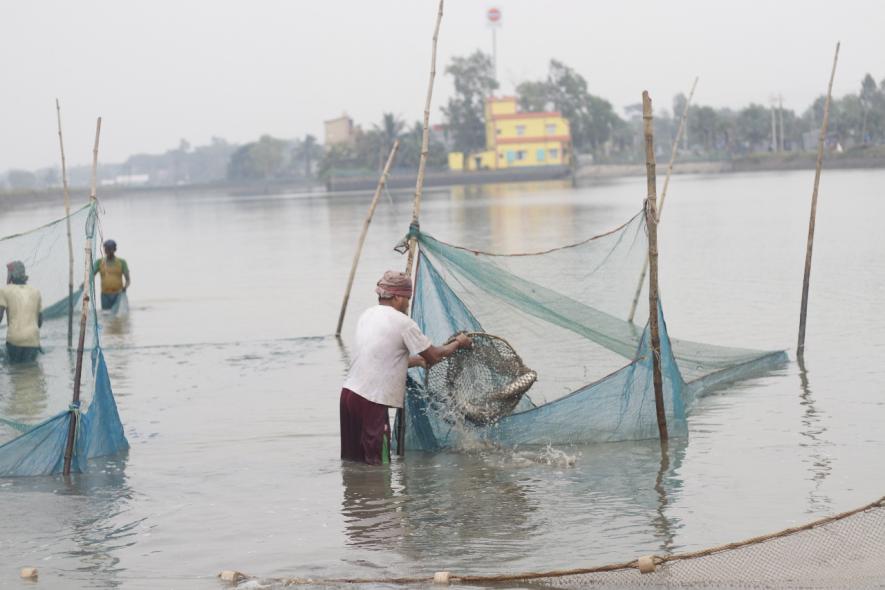
What Scientists Say
Some scientists NewsClick spoke with on the issue were unanimous in voicing their opposition to this flagship project of the Union and West Bengal government.
C.S Chakraborty, former Vice Chancellor, West Bengal University of Animal and Fishery Sciences, Kolkata, said “from 2006 to 2014, I was the Vice Chancellor, and that till that time no model called Moyna existed. Actually, these models are not university affiliated. Now I am hearing from Moyna residents that actually living there was becoming difficult as most of the year the area was submerged due the boat-shaped characteristics of the area.”
This project was taken up with the aim of cutting ponds in the low-lying areas and converting the fields for pisciculture and fish farming using scientific methods. At that time, no big farmers or big capital used to participate in the scheme, as profit was not anticipated, he added.
But after the project became a hit, big capitals and big farmers replaced small farmers. In fact, many highlands too have been converted to ponds where fish farming was being done, he said,
“Even farmlands are being converted to ponds and bheris for fish farming against the law and against nature also. In West Bengal, all are owners of two bigha land, which are being converted and contract farming is being introduced. Whenever farming is being done, different measures are introduced for quick profit, which is against the interests of human beings.”
Chakraborty said, “As per reports available to me, growth enhancing drugs often affect human beings. There is a debate among scientists whether these measures should at all be taken. I am of the opinion that this type of farming, bypassing small marginal fish farmers, should be done away with immediately and farming based on a scientific approach should be introduced.”
A scientist on fisheries, requesting anonymity, said his house was on the Moyna side though he now lived in Kolkata due to work and he had seen the “true tormentors” of the Moyna model, accusing TMC workers of “terrorising the area.” In the past 10 years or more, overt 100 suicides have been reported in Moyna” he alleged, due to poor farmers who landed into debt trap.
Gradually, Moyna model is now being controlled by big capital, he said, alleging that the state government, in spite of opposition from the fisher organisations, were taking measures to popularise the model elsewhere in the state and introduce the same type of blackwater fish farming, “where even residues of dead cows after were being fed to the fish along with unscientific fish feeds for quick muscle enhancement.”
A senior retired government official said the Moyna model had deviated from its initial objective in the pre-2011 days (when the TMC came to power). “This model had been derived from the Andhra model whereby by the side of the rivers, race ways were constructed where fish farming used to take place. Now fish feed is being given which is unscientific in nature, due to rising supplier competition. At that time, we wanted paddy-cum-fish culture, now it is only fish culture, as all the surrounding fields have been taken over for Moyna. The condition is such that standard feed is not given to fish and pond productivity is reducing. Now muscle growth is such that when the fish is cut, the water that oozes out is smelly.”
The government should take measures so that this model does not become anti-farmer, anti-scientific and big capital-oriented, he added.
Several published work in science journals have also opposed this type of pisciculture which introduces toxicity to the human body .
One study “suggests that fish aquaculture in rice fields offers a way to simultaneously produce grain and animal protein on the same plot. Thus, in an age of environmental awareness, there are not many other food production systems that appear as efficient and environmentally sustainable. The term "rice-fish farming" suggests that rice and fish are farmed side by side in the same field while sharing the same water in separate plots. Most pesticides are toxic to a variety of nontarget organisms in addition to the target species since pest and non-pest species share structural and physiological characteristics. Based on the findings of the study, it is possible that humans who consume pesticide-contaminated fish run the risk of health problems due to the pesticide residues identified in C. carpio muscles. Changes in enzymatic and non-enzymatic antioxidants show that these pesticides cause oxidative stress. It was concluded that these pesticides were toxic to C. carpio even at levels that are permitted by law for use in rice cultivation. These pesticide combinations might vary between areas, primarily because of various environmental factors. Temperature, pH, and rainfall indexes are just a few examples of characteristics that vary with diverse climatic circumstances. These qualities are intimately related to the biochemical reactions produced in organisms exposed to various pollutants”.
Get the latest reports & analysis with people's perspective on Protests, movements & deep analytical videos, discussions of the current affairs in your Telegram app. Subscribe to NewsClick's Telegram channel & get Real-Time updates on stories, as they get published on our website.









